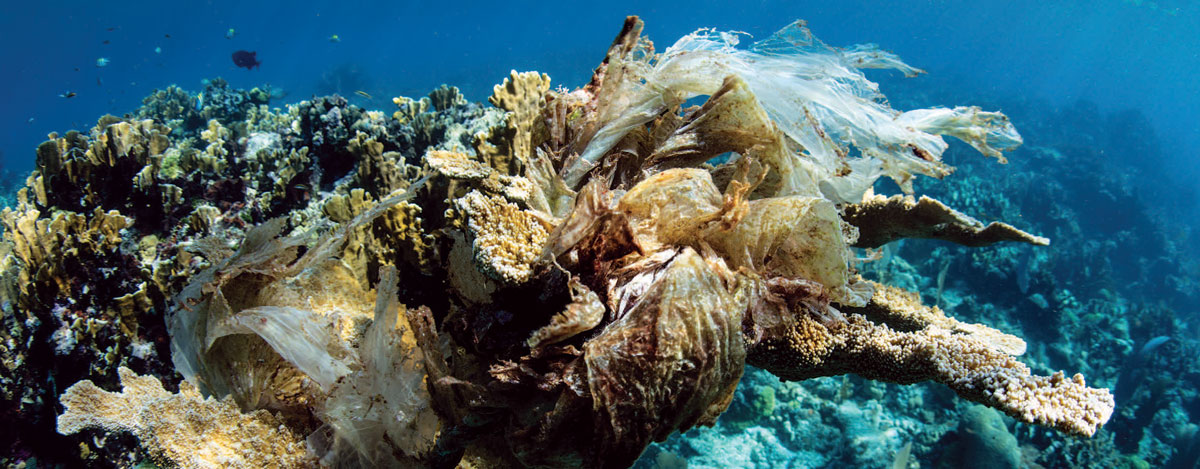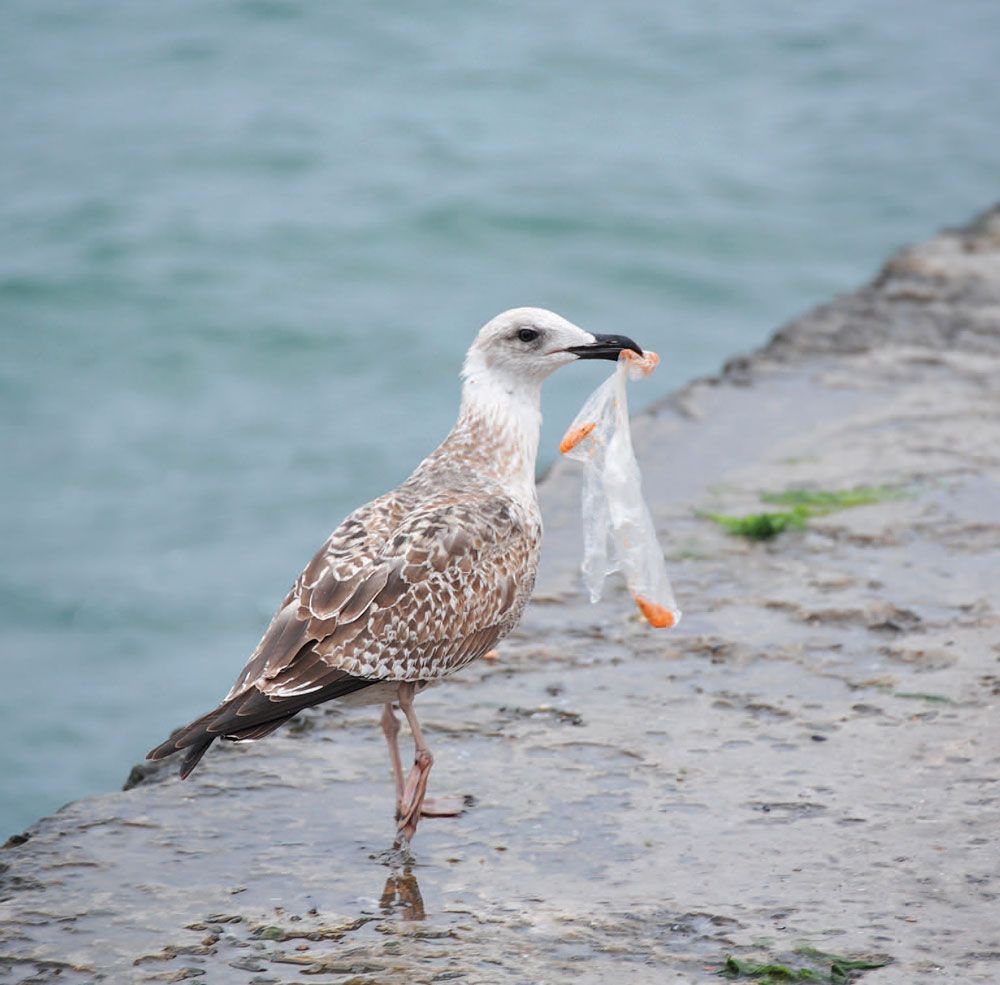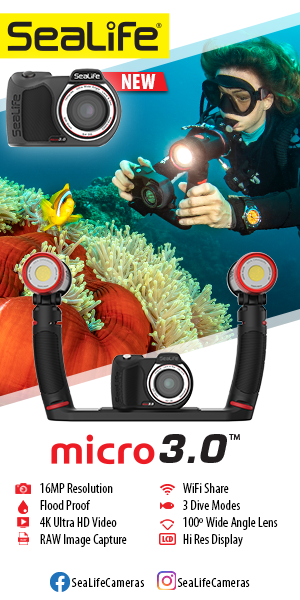I’m roaming a tropical beach, basking in its warmth and beauty. As I stroll the beach, caressed by the gentle surf and swept by the trade winds, the word paradise comes to mind. When I look closer, I see a striking amount of the debris at the high tide line is not natural driftwood, coconut and seaweed. It’s plastic — bottle caps, broken pieces of discarded Styrofoam cups, shreds of plastic bags, straws and countless unidentifiable multi-colored bits ground smooth by the sand and surf. At first blush it’s a problem of aesthetics. Nobody wants to walk along a beach littered with trash, but what I’m seeing is just the edge of the problem — a problem that cuts deep, with consequences beyond what we might imagine when strolling a beach in paradise. It affects not just this one island, but every ocean and beach on every continent. The planet is suffering from an overload of plastic waste.
A 2017 United Nations report revealed that some 800 species of marine life are affected by debris in the ocean, 75 percent of which is plastic: food wrappers, bottle caps, straws, grocery bags and beverage bottles. The report reveals the number of affected species had grown from 663 in 2012 to 817 — a 23 percent increase in just five years. Executive Director Braulio Ferreira de Souza Dias of the Convention on Biological Diversity framed the danger as “one of the most prominent threats to marine ecosystems.”
Fake Food
Perhaps the most visible impact of plastic on marine life is that it is commonly mistaken for food. This is particularly common for various species including birds, sea turtles, fish and whales. Seabirds pecking at the debris at the high tide line cannot distinguish between plastic and life-sustaining food. One reason that plastic may be mistaken for food is that it becomes coated with marine creatures, from microbial slime to algae to barnacles and a host of other species. Thus coated, the plastic parts look and smell like food and are consumed by an array of marine species.
The results, first documented on a Pacific atoll in 1966, are devastating. Birds carry plastic pieces to their young who greedily devour them. But this fake food has virtually no nutritional value. Worse, it clogs their digestive system and can slowly starve them to death. Dead birds are frequently found with a belly full of plastic trash. A million sea birds die annually, victims of ingested plastic.
Whale strandings reveal similar effects. Last fall, National Geographic reported a 31-foot (9.5 m) sperm whale washed ashore in Wakatobi National Park in eastern Indonesia, its belly bloated with 13 pounds (5.9 kg) of plastic trash — 115 cups, 25 plastic bags, plastic bottles, two flip-flops and a bag with over 1,000 pieces of string. And while it isn’t clear if the trashy diet caused the whale’s death, it certainly didn’t improve its health and is an alarming indicator of the perils of plastic refuse in the oceans.
The fake food syndrome affects turtles as well. It’s no longer a question of whether victims have plastic in their digestive systems, but how much they have. According to the Sea Turtle Conservancy, sea turtles have downward facing spines in their throats, making it impossible for them to regurgitate. When a sea turtle swallows a plastic bag mistaken for a sea jelly, the ingested bag blocks its digestive system. Trapped digestive gasses accumulate in the turtle’s digestive system, causing them to float and making them easy targets for predators. Those that evade predators die of starvation.
The fake food problem reaches further into the depths of the marine food web. Tiny fragments of plastic called microplastics are consumed at the lower levels of the food chain and end up in countless species. Example: When plastic bags become coated with a microbial slime — as naturally occurs in the marine environment — they are readily devoured by tiny crustaceans known as Orchestia gammarellus found in European waters. This species can shred a plastic bag into well over a million tiny plastic particles and excrete them in the form of microplastics that find their way into every corner of the oceans.
While we might think of anchovies as something to put on pizzas (or not!), they form the foundation of a marine food web that ultimately feeds massive quantities of commercially important fish such as tuna and sea bass. Anchovies are a significant food source for virtually every predatory fish in their environment, as well as other species including birds and marine mammals such as seals and sea lions. But it’s not just marine species that rely on anchovies as a primary protein source. Millions of tons of anchovies are commercially harvested annually for bait, fishmeal, pig food, poultry feed and aquaculture.
The problem is what the anchovies are eating. Anchovies are filter feeders, consuming copious quantities of marine algae and plankton. But that isn’t all they’re filtering. A 2017 research article published by The Royal Society reveals that plastic debris floating in the ocean picks up a characteristic odor that attracts fish such as anchovies. The anchovies actively seek out and consume plastic materials — along with any contaminants the plastic may have collected — and that plastic ends up in everything that eats anchovies.

Plastic debris that enters the sea becomes part of the marine food web and accounts for untold numbers of deaths of marine animals, ranging from seabirds, sea turtles and whales.
A Vector for Disease and Contamination
The surface chemistry of plastic allows toxins to readily accumulate on its surface. As the plastic is consumed by marine life, the toxins accumulate, building to many times the levels found in the environment — an effect known as biomagnification. As such, the plastic becomes a vector for disease in higher order species and can eventually make its way into human consumers.
The potential for disease and contamination is perhaps worst for those who make their home in the sea. A January 2016 article in the journal Science by researchers Joleah B. Lamb et. al. reveals how corals that come in contact with plastics are 20 times more likely to become diseased. As the authors explain, “Plastic debris stresses coral through light deprivation, toxin release and anoxia, giving pathogens a foothold for invasion.” And it isn’t just a solitary reef where the effects are seen. The authors state, “We assessed the influence of plastic waste on disease risk in 124,000 reef-building corals from 159 reefs in the Asia-Pacific region. The likelihood of disease increases from 4 percent to 89 percent when corals are in contact with plastic.”
Entanglement
Still for some species, it’s the large plastic items causing the problem. Much of the lost and discarded plastic becomes an entanglement hazard for marine life. From discarded fishing nets to six-pack rings, this plastic waste becomes a fatal trap for many forms of sea life from sea turtles to dolphins.
The Depths of Despair
A common misconception is that plastics in the oceans is just a surface issue, confined to the first 10 feet of the ocean surface, or in littoral areas, including reefs and along the shorelines. But recent research has cast that myth aside like a battered styrene coffee cup.
Marine biologist Alan Jamieson and his student, Lauren Brooks, from Newcastle University in Australia weren’t looking for plastic, they were collecting amphipods — small shrimp-like creatures — from the deepest trenches of the ocean to see how they differed from one another. But when they tested the critters for human-made toxins, they got a real surprise — amphipods had toxic polychlorinated biphenyl (PCB) levels 50 times higher than those found in the most polluted rivers in China. Then one day Brooks found a hair-like sliver of plastic in the gut of an amphipod hauled up from the depths and their research took a turn. Examining amphipods from six deep trenches in the Pacific, they found plastic fibers and pieces in 72 percent of the creatures. Examining amphipods pulled from the deepest part of the ocean, the Mariana Trench — nearly seven miles below the surface — they found plastic in every single one.
Even the deepest depths of the oceans are becoming permeated with plastic pollution. Researchers from the Institute of Deep Sea Science and Engineering in Hainan, China found staggering concentrations of microplastics in the Mariana Trench — 2,200 pieces per liter in sediments and 13 pieces per liter in the water.
According to the first rigorous global estimate that was published in Science in 2015, around nine million tons of plastic finds its way into the oceans every year. The new study also identified the major sources of plastic debris and named the top 20 countries generating the greatest amount of ocean-bound trash. China is first. The United States is 20th. The rest of the list includes 11 other Asian countries, Turkey, five African countries and Brazil.
The fragments and microplastics of plastic fall through the water column like snow. But this snow never melts: it becomes part of the landscape and the food chain — part of a man-made disaster that threatens nearly every form of life.
The Growing Plastic Overload
It might seem like plastic has been around forever and, in truth, it’s hard to find a modern product that isn’t comprised at least in part by plastic. Virtually everything we eat is packaged in plastic, stored in plastic or carried from the store in plastic. It’s in the cars we drive, the clothes we wear, the homes in which we live and the tech we use every day. It’s vital to our lives. But plastic is a relatively new material on the planet, having made its debut in the 1940s. World production of plastic has been rocketing skyward, from 2.3 million tons in 1950, to 162 million tons in 1993, to a stunning 448 million tons in 2015. Half of the total 9 billion tons of plastic produced on Earth was manufactured in the past 15 years. With a lifespan of up to 450 years or more, it won’t disappear any time soon.
The problem is not just the amount of plastic products created, but the fact that 40 percent of them are single-use products with an incredibly short “working life.” A trillion plastic bags are manufactured yearly, with an average working life of just 15 minutes. Some 50 billion water bottles are produced in the US each year — enough to stretch from the Earth to the Moon more than 26 times. We use them once and discard them.
Recycling Gone Awry
One obvious answer to the growing plastic overload is recycling. Most of us recycle to at least some degree — collecting paper, metal and plastic refuse so it can be collected, recycled and reused. In theory, recycling plastic seems like a simple and practical solution to limit the amount of “virgin” plastic produced. Despite efforts, recycling faces major challenges. Only a fraction of the plastic manufactured today is recycled. Of the nine billion tons produced, nearly seven billion tons have become waste, with only half a billion tons having ever been recycled.
Recycling plastic is not as simple as we might imagine. First, consumers must save the plastic items for recycling. Then they need to be collected, sorted, processed into a viable material and then used to make a new product. Finally, to make the whole scheme work, we need consumers willing to purchase the products made from recycled plastic. Challenges arise in every step along the way.
Getting people to set aside their plastic items for recycling isn’t always easy and confusion about what can and should be recycled helps defeat the effectiveness of the process.
The next step is proper sorting by type, which must be done accurately and efficiently. Small amounts of the wrong type of plastic can degrade the recycled product, making it much less suitable (and less valuable) for reuse. After recyclables are collected, further sorting is required and, although some of the process is automated, hand sorting is still an integral part of the process. To properly sort the plastic means slowing down the process, which increases costs.
Once sorted, the plastic can be processed for reuse. Again, impurities in the plastic can greatly influence the quality of the product. If a load of sorted plastic doesn’t meet quality standards, then buyers are less likely to purchase it since it’s more economically viable to produce virgin plastic than to suffer the losses that come from contamination.
Perhaps the biggest setback in recycling of plastic came in the 2017 decision by China to cease imports of plastics for recycling. According to NPR, about 106 million metric tons of plastic — roughly 45 percent of the world’s plastic collected for recycling — has been exported to China since 1992. The sudden change in China’s regulations has left many recycling companies in the U.S. and, elsewhere, in the lurch. Without the infrastructure to process the recyclable plastics, much of it has been diverted to landfills and incinerators.
Plastic Pushback
It’s hard to imagine a world without plastic, but the industry is getting some serious pushback — especially for single-use products (visit plasticpollutioncoalition.org and oceana.org/our-campaigns/plastics for more on the topic). This is something we can all take part in.
One hot-button issue has been single-use shopping bags. Plastic bags are not only widely implicated in wildlife deaths, but they jam up the works of recycling plants. Following in the footsteps of Hawaii and California, New York state recently approved a statewide ban on most single-use plastic bags from retail sales. Other states and municipalities are also considering such bans to curb the damage caused by discarded plastic bags.
Plastic straws hit the market in the 1960s and have become popular because they’re better, cheaper and stronger than paper straws. A few hundred million plastic straws are used in the U.S. alone every day — but they defy recycling efforts due to their shape, size and material. A typical plastic straw takes 200 years to biodegrade. In July of 2018, Seattle became the largest city to ban plastic straws, mostly due to consumer backlash, and others are joining in. Starbucks plans to phase out plastic straws by 2020 and McDonald’s will ban their use in its restaurants in the United Kingdom and Ireland.
Another pushback is a shift away from styrene — particularly the foam coffee cups and clamshell food containers. The base material is very brittle and readily breaks down into small pieces commonly mistaken for food and easily ingested. Styrene doesn’t recycle well and contaminates other types of plastics in the recycling process.
Bans like these are an effective way of limiting plastic overload, so one way to make a difference is to exercise our voice and our vote. Vote on reasonable measures at the ballot box: let your representative know you care. But perhaps even more importantly, we must encourage manufacturers to stop producing items that have unnecessary plastic items and those not easily recycled and have damaging downstream effects.
Renewing the Efforts
Despite the news of how plastic is smothering life on our planet, there is hope that the challenges can be overcome. As resource economist Ted Siegler is quoted in a recent National Geographic article on plastics, “This isn’t a problem where we don’t know what the solution is. We know how to pick up garbage. Anyone can do it. We know how to dispose of it. We know how to recycle.” As Siegler notes, it’s a matter of building the necessary institutions and systems — ideally before the ocean turns irretrievably and for centuries to come, into a thin soup of plastic.
In an age of tech and creative expression, the most important tools we have to combat plastic overload are innovative minds, far-reaching communication, financial investment and people willing to personally take on the challenges.
One of today’s innovative minds is Ivy-league educated engineer and entrepreneur Arthur Huang, who in 2005 founded Miniwiz, a company dedicated to “upcycling and consumer trash and industrial waste reuse innovation.” Among his efforts is the development of the solar-powered “Trashpresso,” a portable plastic recycling plant that converts plastic trash into building materials. The Trashpresso shreds and compresses plastic bottles and other plastic trash into small tiles to be used for construction of walls and floors.
Another notable leader in the war against ocean-borne plastic is entrepreneur Boyan Slat, the 24-year old Dutch inventor of a solar-powered plastic recovery system designed to clean up the Great Pacific Garbage Patch — a slowly spinning gyre said to be twice the size of Texas located in the middle of the Pacific Ocean between Hawaii and the United States’ West coast. Due to global surface current circulation, stray plastics such as Styrofoam cups, plastic bags, discarded water bottles and abandoned fishing nets collect as a thin plastic soup in this region and in other gyres in other oceans. An estimated 79,000 metric tons of plastic are floating in the Great Pacific Garbage Patch — a problem that Slat and his Ocean Cleanup project (theoceancleanup.com) intend to rectify. His brainchild, called “Wilson,” is essentially a 600 meter (3.7-mile) U-shaped floating boom with a net system extending 3 meters (10 feet) underwater to strain the soup and capture the plastic. As reported in The Guardian, a team of 70 scientists and engineers spent five years testing 273 models and six prototypes before Wilson was towed out into the Pacific for testing in 2018. Unfortunately, it failed. Some shortcomings in Wilson’s design were discovered that require redesign and it’s unclear whether the $20 million spent so far will ultimately lead to success, but Slat’s team presses on.
Taking on the Personal Challenge
Not all of us are entrepreneurs and engineers but there are actions each of us can take to minimize plastic overload. For some, it’s as simple as learning more about recycling and ensuring we do what’s needed to ensure a viable recycling stream in our own community. For all of us, part of the solution is making the right choices as consumers. That means avoiding single-use plastics and other unnecessary plastic products.
Actions, such as beach cleanups, not only help remove plastic refuse from the environment but can draw attention to the problems created by plastic waste, help educate the public and stimulate development of policies that drive plastic use and recycling in the right direction.
Social media is a powerful tool to bring awareness and drive people to action and the recent #trashtag challenge is a great example. The idea is to pick a location where plastic (and other) trash is found, clean it up, bag the trash and then post the before and after photos to social media. The idea has gone viral, with cleanups occurring around the world. Reddit readers have been enamored with the recent cleanup efforts, with #trashtag gaining over 1,000 subscribers in a single weekend.
My stroll along the beach ended with a small gesture unworthy of note — discarding plastic trash in a nearby receptacle. I ponder the limits of the ocean before me and the mind-numbing numbers. I can’t comprehend a billion of anything — but 18 billion pounds of plastic per year can’t be good. It’s a crisis of epic proportion, the far-reaching effects of which we are only beginning to understand. The question becomes, what will each of us do about it?







